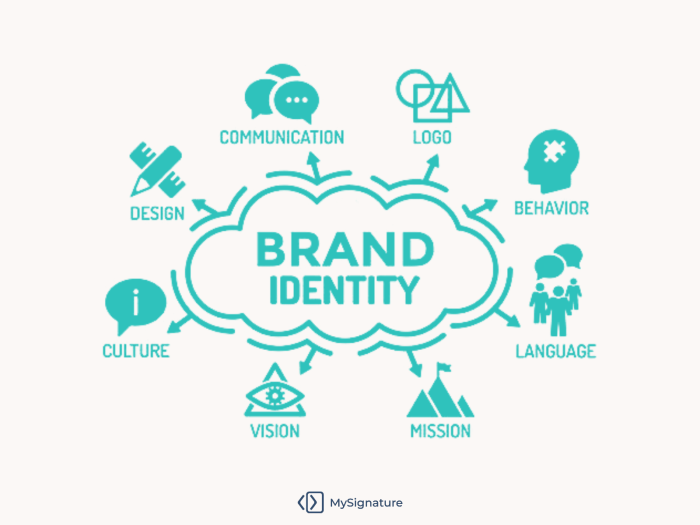Creating a Brand Identity dives deep into the world of branding, exploring how businesses establish their distinct persona through visual elements and messaging. From selecting the perfect logo to defining color schemes, this topic is all about standing out in a crowded market.
Defining Brand Identity

Brand identity encompasses the visual, emotional, and cultural elements that set a business apart from its competitors. It represents the company’s values, mission, and personality, shaping how it is perceived by consumers.
Hey, you know how everyone’s always on their phones these days? Well, if you’re trying to reach out to peeps on the go, you gotta make sure your content is mobile-friendly. Check out this dope article on Developing Content for Mobile Users for some killer tips on how to keep your audience engaged!
Elements of Brand Identity
- Logo: A symbol or graphic that represents the brand visually.
- Color Scheme: Consistent colors used throughout brand materials to evoke specific emotions or associations.
- Typography: The style of fonts used in branding materials, reflecting the brand’s personality.
- Messaging: The tone, voice, and language used in communication, conveying the brand’s values and positioning.
Importance of Strong Brand Identity
A strong brand identity is crucial for businesses to stand out in a crowded market, build recognition, and establish a loyal customer base. It differentiates a brand from competitors and creates a memorable impression that resonates with consumers.
Influence on Consumer Perceptions and Loyalty
Brand identity plays a significant role in shaping how consumers perceive a brand. It builds trust, credibility, and emotional connections with customers, leading to increased loyalty and repeat business. Consistency in branding elements reinforces the brand’s image and fosters long-term relationships with consumers.
Creating a Brand Identity
Creating a brand identity is a crucial process that involves several key steps from research to implementation. It helps in establishing a unique and recognizable image for a company or product.
Research and Strategy
Before diving into the design process, thorough research about the target market, competitors, and industry trends is essential. This helps in understanding the audience and positioning the brand effectively.
Yo, developing content for mobile users is crucial in today’s digital era. With more peeps using their phones to surf the web, it’s important to make sure your content is optimized for mobile devices. Check out this dope article on Developing Content for Mobile Users to learn some lit tips and tricks on how to create killer content for mobile users.
Stay ahead of the game, y’all!
Visual Identity Development
Designing a logo is a central part of a brand’s visual identity. It should be simple, memorable, and reflective of the brand’s personality. Selecting colors and typography that resonate with the brand’s values and message is also crucial in creating a cohesive visual identity.
Alignment with Values and Audience
It’s important to align the brand identity with the company’s values, mission, and target audience. This ensures consistency in messaging and helps in building trust and loyalty among customers.
Successful Brand Identity Strategies, Creating a Brand Identity
- Apple: Apple’s minimalist logo and sleek product design reflect its commitment to simplicity and innovation.
- Nike: Nike’s iconic swoosh logo and bold branding appeal to athletes and individuals striving for excellence.
- Coca-Cola: Coca-Cola’s timeless logo and classic red color scheme evoke feelings of happiness and nostalgia, aligning with its brand values.
Consistency in Brand Identity

Consistency in brand identity is crucial for businesses to build trust, recognition, and loyalty among their target audience. It ensures that customers can easily identify and connect with the brand regardless of the marketing channel or touchpoint.
Importance of Consistency
- Consistent brand identity reinforces brand values and messaging, creating a strong brand image.
- It builds credibility and trust with customers, as they know what to expect from the brand.
- Consistency helps differentiate the brand from competitors and increases brand recall.
Challenges in Maintaining Consistency
- Adapting brand messaging and visuals to different marketing channels while staying true to the brand identity.
- Ensuring all employees and stakeholders understand and follow brand guidelines.
- Managing external agencies and partners to maintain consistency in brand communication.
Tips for Creating Brand Guidelines
- Define brand values, voice, and personality to guide all marketing materials.
- Create a brand style guide with specifications for logo usage, colors, fonts, and tone of voice.
- Provide training and resources for employees to ensure consistent brand representation.
Brands with Consistent Identity
- Apple: Known for its minimalist design, sleek products, and consistent brand messaging across all platforms.
- Coca-Cola: Maintains its iconic red and white color scheme and timeless logo for decades.
- Nike: Recognizable by its “Just Do It” slogan and the swoosh logo, consistently used in all marketing materials.
Evolving Brand Identity
In the dynamic world of business, it is essential for brands to evolve their identities over time to stay relevant and competitive in the market. This evolution can be driven by various factors such as changing customer preferences, market trends, technological advancements, or even internal restructuring.
Reasons for Brand Evolution
- Adapting to Changing Consumer Preferences: Brands may need to evolve their identity to resonate with the evolving tastes and preferences of their target audience.
- Keeping Up with Market Trends: Staying abreast of industry trends and innovations may require brands to refresh their identity to remain current and appealing.
- Repositioning in the Market: A brand may choose to evolve its identity to reposition itself in the market and target new customer segments.
Successful Rebranding Examples
- Apple: Apple successfully rebranded itself from a niche computer company to a global tech giant by focusing on innovation and sleek design.
- Starbucks: Starbucks rebranded its logo and store design to create a more modern and eco-friendly image, appealing to a younger audience.
- Burberry: Burberry revitalized its brand by updating its product line and marketing strategies to attract a younger demographic while maintaining its luxury appeal.
Steps in Rebranding
- Conducting Research: Understand market trends, consumer preferences, and competitor strategies to inform the rebranding process.
- Developing a New Brand Strategy: Define the brand’s vision, values, and positioning to guide the rebranding efforts.
- Updating Brand Elements: Refresh the logo, colors, typography, and other visual elements to reflect the new brand identity.
- Communicating Changes: Clearly communicate the rebranding to customers, employees, and stakeholders through various channels to ensure a smooth transition.
Communicating Brand Changes
- Engage with Customers: Seek feedback from customers and involve them in the rebranding process to create a sense of ownership and loyalty.
- Use Multiple Channels: Utilize social media, press releases, events, and other platforms to announce and explain the changes in brand identity.
- Be Transparent: Clearly communicate the reasons behind the rebranding and how it will benefit customers to build trust and credibility.